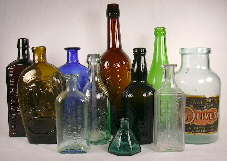|
ADDITIONAL IMPORTANT INFORMATION
|
"ENCYCLOPEDIA OF MANUFACTURERS
MARKS ON
GLASS CONTAINERS"
This
work is a massive treatise on
American glass container manufacturers
from the late 18th century to the
present day more or less. As of early
2021 all of the Makers Markings sections
are complete! If
printed out (well over 6000 pages!) it comprises
the complete 14 volumes of the "Encyclopedia of Manufacturers
Marks on Glass Containers."
Although complete now, Bill Lockhart (U.
of New Mexico [retired] and the primary
author of these articles) and the
Bottle Research Group
are now in the process of revising many
of these completed and published
articles adding additional information
found since the original publishing date.
Final copies of
all the alphabetical "Logo Tables" - PDF
tables of the actual markings, the
associated glass makers that used them,
and dates of use - are posted in their
entirety just below. All of the
"A" through "Z" manufacturers article
links are found on the
Bottle & Glass Makers Markings
page. Supplementary files to complete each
alphabetical section - e.g.,
"Preface/Introduction & Table of
Contents" and the pertinent "List of
Factories" and "Logo Table" of
actual bottle markings - have been
posted and linked in the appropriate alphabetical
section on that same page.
|
Makers Markings Logo Tables
As a part of the above noted "Encyclopedia of
Manufacturers Marks on Glass Containers" project is the completion of the "Makers Markings Logo
Tables" by the BRG - a major milestone in assisting with the dating of
historic bottles. This alphabetical listing of specific embossed
bottle/glass containers makers markings includes the marks used by various bottle/glass
making companies in the United States and Canada as well as some in England
and Mexico. The actual makers marking "logos" are listed along with
the name of the company that used the marking, the date range for the use of
that marking, and the makers marking article(s) that cover that particular
marking and maker. These tables taken as a whole constitute
essentially a "quick reference" dating guide to the makers markings found on
historic bottles!
|
Makers Markings Logo Tables
All the above articles
and tables are now (early 2021) considered final although
any may be revised
in the future as new information is available. |
A comprehensive history &
markings of the Owens-Illinois Glass Company
 Questions pertaining to the products of the Owens-Illinois Glass Co.
outnumber many fold the questions this websites' author receives about any
other particular glass/bottle maker. The previous article(s) on the
company posted on this website have also received significantly more user
downloads than any other makers marking article. (Image to the right
of an O-I produced beer bottle base.) Questions pertaining to the products of the Owens-Illinois Glass Co.
outnumber many fold the questions this websites' author receives about any
other particular glass/bottle maker. The previous article(s) on the
company posted on this website have also received significantly more user
downloads than any other makers marking article. (Image to the right
of an O-I produced beer bottle base.)
Given that there is much new information gleaned since the 2015 article (Lockhart
& Hoenig 2015), Bill Lockhart recently combined all of the currently
known information on the complicated history of the company into two
separate articles - Part 1 which is the overall history of the company and
various plants and, Part 2 which is an explanation of the various makers
markings, date and plant codes and related features f0und on their products.
Both articles follow and are part of the above noted "Encyclopedia of Manufacturers Marks on Glass Containers":
Lockhart, Bill, Russ Hoenig,
Beau Schriever, Bill Lindsey and Carol Serr. 2018t. Owens-Illinois Glass Co.
Part 1 - History.
Historic Glass Bottle Identification & Information
Website, E-published October 2018.
This is an in-depth overview of the history of this important 20th and still
currently operating company, including the myriad of plants the company used
and still use.
This article is
available at the following link:
Owens-Illinois Glass Company Part 1 - History.
Lockhart, Bill and Russ Hoenig. 2018u.
Owens-Illinois Glass Company Part 2 - The Bewildering Array
of Owens-Illinois Glass Co. Logos and Codes.
Historic Glass Bottle Identification & Information
Website, E-published October 2018.
(Note: Russ Hoenig is a now retired senior engineer of the
Owens-Illinois Glass Co. and a rich source of information. Thanks
Russ!) This is an important and substantive update that goes further
in explaining the array of markings used by the company on its products over
the past 90 years.
This article is
available at the following link:
Owens-Illinois Glass Company Part 2 - Logos & Codes.
Other recent
articles of interest
|
The following articles are on very
commonly encountered bottles: Pitcher's/Fletcher's Castoria,
Bromo-Seltzer's, Vaseline, California Fig Syrup, Phillips Milk
of Magnesia, Dr. Price's Flavoring Extracts, W. T. Rawleigh Co.,
Horlick's Malted Milk and Curtice Brothers Catsup. The
history of these products and their glass containers is useful to
archaeologists (and others) due to their ubiquity in that the many different
varieties of bottles used for the products can be reliably dated (within
ranges). This potentially allows for the dating of other historic
bottles and items found within the same context.
Lockhart, Bill, Beau Schriever,
Carol Serr, and Bill Lindsey with contributions by Joe Widman. 2014.
Pitcher's and Fletcher's Castoria Bottles - An Uncommon Study of Common
Bottles.
Historic Glass Bottle Identification & Information
Website, E-published October 2014.
Article on the fascinating history, bottles and (some) makers markings of this
well know product (Castoria) that is still in production (Fletcher's
Castoria) today.
This article is available at this link:
http://www.sha.org/bottle/pdffiles/CastoriaHistory.pdf
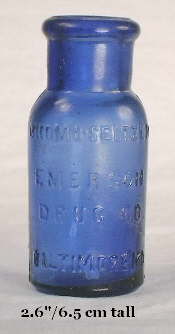 Lockhart, Bill, Pete Schulz, Bill
Lindsey, Beau Schriever,
and Carol Serr with contributions by David Whitten. 2014.
Bromo-Seltzer in the Cobalt Blue Bottles.
Historic Glass Bottle Identification & Information
Website, E-published December 2014.
Another exclusive article published here only; this one on
the fascinating history and bottles of another well know product (Bromo-Seltzer)
that is still in production today.
This article is available at this link:
http://www.sha.org/bottle/pdffiles/Bromo-Seltzer.pdf
(Image to the right of a small, mouth-blown Bromo-Seltzer.) Lockhart, Bill, Pete Schulz, Bill
Lindsey, Beau Schriever,
and Carol Serr with contributions by David Whitten. 2014.
Bromo-Seltzer in the Cobalt Blue Bottles.
Historic Glass Bottle Identification & Information
Website, E-published December 2014.
Another exclusive article published here only; this one on
the fascinating history and bottles of another well know product (Bromo-Seltzer)
that is still in production today.
This article is available at this link:
http://www.sha.org/bottle/pdffiles/Bromo-Seltzer.pdf
(Image to the right of a small, mouth-blown Bromo-Seltzer.)
Lockhart, Bill. 2015. A Tour Through Time in Vaseline
Jars.
Historic Glass Bottle Identification & Information
Website, E-published August 2015.
Another exclusive article published here only; this one on
the fascinating history and bottles of yet another well know product (Vaseline)
that is still in production today.
This article is available at this link:
http://www.sha.org/bottle/pdffiles/Vaseline2015.pdf
Lockhart, Bill and Beau Schriever.
2018. California Fig Syrup: The Company and its Bottles.
Historic Glass Bottle Identification & Information Website, E-published June 2018.
Another exclusive article published here only; this one on
the fascinating history and bottles of another well know product (California
Fig Syrup)
that is still in production today.
This article is available at this link:
http://www.sha.org/bottle/pdffiles/CaliforniaFigSyrup.pdf
Lockhart, Bill, Beau Schriever and Carol Serr.
2018. The Bottles of Phillips Milk of Magnesia.
Historic Glass Bottle Identification & Information Website, E-published June 2018.
Another exclusive article published here only; this one on
the fascinating history and bottles of another well know product (Phillips
Milk of Magnesia)
that is still in production today.
This article is available at this link:
http://www.sha.org/bottle/pdffiles/MilkOfMagnesia.pdf
Lockhart, Bill. 2020a. Dr. Price's Delicious Flavoring
Extracts.
Historic Glass Bottle Identification & Information
Website, E-published March 2020.
Another exclusive article published here only; this one on
the fascinating history and bottles of another well known product (Dr.
Price's Flavoring Extracts) which was produced and very popular during
the last quarter of the 19th century until at least 1938.
This article is available at this link:
http://www.sha.org/bottle/pdffiles/PricesExtracts.pdf
Lockhart, Bill. 2020b. W. T. Rawleigh Co.
Historic Glass Bottle Identification & Information
Website, E-published March 2020.
Another exclusive article published here only; this one on
the fascinating history and bottles of a major patent medicine producer (W.
T. Rawleigh Co.) who began in business during the late 19th century and
is still in business today (or at least as late as 2018).
This company used a wide variety of largely machine-made bottles for their
products.
This article is available at this link:
http://www.sha.org/bottle/pdffiles/RawleighCompany.pdf
Lockhart, Bill, Bob Brown,
Beau Schriever, Carol Serr and Bill Lindsey. 2020.
Horlick's Malted Milk. Historic Glass Bottle Identification & Information
Website, E-published November 2020.
Another exclusive article published here, this one being on the
history and bottles/jars of the Horlick's Malted Milk Co.
The product was produced in various forms (powder, tablets, liquid) and
was advertised as "Horlick's Malted Milk for Infants, Invalids, the Aged
and Travelers" as it was sterile, portable and easy to consume (by
those with no teeth?). The company began business in the U.S. during the last quarter of the
19th century expanding into England by the 1890s and continuing through the
entire 20th century. It is still is being produced in England (the
U.S. factory closed in the 1970s) for various markets around the world.
This company used a wide variety of mouth-blown and machine-made
bottles for their product during that time period. This article is
available at the following link:
http://www.sha.org/bottle/pdffiles/Horlicks.pdf
Lockhart, Bill, Bob Brown,
Beau Schriever, and Bill Lindsey with contributions from John Lord and Barry
Bernas. 2022b. Curtis Brothers - The Pepsi-Cola
of Catsup Packers. Historic Glass
Bottle Identification & Information Website, E-published October 2022.
This is an article on the history of and bottles used (many types) by Curtis
Brothers (New York and other locations) for bottling their catsup/ketchup
from the origin of the company during the American Civil War until after the
mid-20th century when it merged with another company which is still in
business today. This article is available at the following link:
http://www.sha.org/bottle/pdffiles/CurticeBrothers.pdf
Lockhart, Bill and Bob Brown.
2022c. Moxie Nerve Food - Bottles and History. Historic
Glass Bottle Identification & Information Website, E-published December
2022. Article on this well known product which began as a patent
medicine ("Nerve Food") and eventually morphed into a beverage/soda which is
still sold in New England today. This article is available at the
following link:
http://www.sha.org/bottle/pdffiles/MoxieArticle.pdf
...probably more product bottle specific articles to come in the
future.
|
  Lockhart, Bill and Bob Brown.
2024.
The Seven-Up Company and 7-Up Bottles - The Real
Story - A Look at the Myths, the Mystery, and The Magic. Privately
published e-Book found only on this website. This
is a comprehensive history of 7-Up glass bottles from the 1930s to 1960s.
This fully illustrated e-book is now
available ONLY ON THIS WEBSITE as a series of copyrighted pdf files which may be printed out
to make your own book for no cost...thanks Bill and Bob! Lockhart, Bill and Bob Brown.
2024.
The Seven-Up Company and 7-Up Bottles - The Real
Story - A Look at the Myths, the Mystery, and The Magic. Privately
published e-Book found only on this website. This
is a comprehensive history of 7-Up glass bottles from the 1930s to 1960s.
This fully illustrated e-book is now
available ONLY ON THIS WEBSITE as a series of copyrighted pdf files which may be printed out
to make your own book for no cost...thanks Bill and Bob!
Cover, Table of Contents, Preface and Introduction
Chapter 1 - Seven-Up History
Chapter 2 - Paper Labels and Early Logos
Chapter 3 - Colorless and Amber Seven-Up Bottles
Chapter 4 - Emerald Green Seven-Up Bottles
Appendix A - History of the Carthage Bottling Works
Appendix B - A Note on Historical Research
Appendix C - Seven-Up Trademark Registrations
Appendix D - World War II Bottle Caps
Appendix E - Faust Brand Beer and Sodas
Lockhart, Bill and Bob Brown (with contributions by Chris
Weide and Russ Hoenig).
2019. The Glamorous Applied
Color Labels.
Historic Glass Bottle Identification & Information
Website, E-published September 2019. A comprehensive article on the
history, processes and use of ACL labeling beginning in the early 1930s.
This article is available on this site at:
http://www.sha.org/bottle/pdffiles/ACLArticle2019.pdf
Schulz,
Peter, Bill Lockhart, Carol Serr, Bill Lindsey and Beau Schriever.
2019b. A History of Non-Returnable Beer Bottles.
Historic Glass Bottle Identification & Information Website, E-published
February 2019.
Another exclusive article published here only; this one an in-depth and
fascinating history of non-returnable beer bottles. Though not an era
that has completely ended, the heyday of no-deposit, no-return bottles was
primarily from the 1930s to 1970s. This article covers styles, dating,
and much more about this category of bottles which are ubiquitous on 20th
century historic sites.
This article is available at this link:
http://www.sha.org/bottle/pdffiles/NRBeers.pdf
Lockhart, Bill, Tod von Mechow, Beau Schriever, David Whitten, Bill Lindsey
and Carol Serr.
2014. William Painter's Baltimore Loop Seal.
Historic Glass Bottle Identification & Information
Website, E-published January 2014.
This article is web published here exclusively for users! It is about
this late 19th century (but used into the 1910s) closure type used for beer
and soda bottling and invented by William Painter, who went on to much
bigger fame as the originator of the crown cap closure and finish.
This article is available at this link:
http://www.sha.org/bottle/pdffiles/BaltimoreLoopSealarticle.pdf
Lockhart, Bill, Bill Lindsey,
Beau Schriever, and Carol Serr.
2012. New Insights from the Bottles Excavated at the Fort Riley
Hospital Privy. Privately published by Bill Lockhart & the Bottle
Research Group. This well illustrated work highlights the recent
reanalysis of hundreds of bottles and bottle fragments systematically
excavated in 1984 from a large privy at Fort Riley, KS. used from the late
1850s into the 1890s. The reanalysis resulted in the identification of
several previously non-attributed makers markings as well as provided a
significant amount of information to affirm and refine many of the concepts
and dating guidelines found on this site.
This copyrighted work is available for sale as a softbound
book via
www.Lulu.com (search using "Bill Lockhart") or as a free,
downloadable .pdf file which may be saved or printed out to make your own
book for no cost! The file is available at this link: http://www.sha.org/bottle/pdffiles/FortRileyReport2012.pdf
|
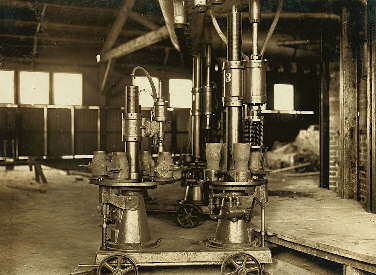 Another significant
addition to this website, which will be ongoing for some time, is the
inclusion of a series of articles primarily authored by Bill Lockhart
on the early bottle making machines from the very late 1800s to the
first couple decades of the 20th century. These are highly
informative, interesting and well illustrated articles on the early
days of bottle making automation! Another significant
addition to this website, which will be ongoing for some time, is the
inclusion of a series of articles primarily authored by Bill Lockhart
on the early bottle making machines from the very late 1800s to the
first couple decades of the 20th century. These are highly
informative, interesting and well illustrated articles on the early
days of bottle making automation!
Bernas, Barry. 2011. The
Evolution of Jar Machine. (Originally privately published as part of
the 2011 Fruit Jar Annual.) This article is being made
available here compliments of the author and is a fascinating history of the
late 19th century evolution of wide mouth, press-and-blow jar making
technology and machines. Click on the following link to access this
article:
http://www.sha.org/bottle/pdffiles/evolutionjarmachineBernas.pdf
Lockhart, Bill.
2014. Frank O'Neill and the O'Neill Glass Machines.
Historic Glass Bottle Identification & Information
Website, E-published February 2014.
Another great article web published here exclusively! This article is about
some significant late 19th to early 20th century, press-and-blow, semi and
fully automatic machines that were eventually able to make narrow neck
bottles as well as wide mouth bottles and jars. This article is
available at this link:
http://www.sha.org/bottle/pdffiles/ONeillmachines.pdf
(The 1908 photo above right is from the Lewis Hine collection at the
Library of Congress and shows an early, probably O'Neill (Barrett 2011) semi-automatic 4 mold
press-and-blow milk bottle
machine, with the following caption: "Machine that
blows 4 milk bottles at a time. No
"lung blowers" employed. Travis
Glass Co., Clarksburg W. Va. Manager
says machines are fast coming into play in bottle industry, plans eventually to
have machines in place of "carrying in boys." Location: Clarksburg, West
Virginia" [Library of Congress].)
Lockhart, Bill and Barry Bernas.
2014. Turning Blue: Charles Blue and the Early Jar Machines.
In the "Guide to Collecting Fruit Jars: Fruit Jar Annual 2014" by
Jerry McCann , pp. 19-47. Privately published.
As noted in the articles introduction:
Charles Edwin Blue created the first
really successful jar and wide-mouth bottle machine. Between 1894 and
1912, Blue patented ten such machines, corresponding to the rise of
the Atlas Glass Co. – from 1896 to 1902. This study examines the
earliest machines – made by Blue and others – the manufacturing
characteristics they left on jars, and ramifications applied to
identifying early jars made by the Atlas Glass Co.
This article is available on this website at this link:
http://www.sha.org/bottle/pdffiles/TheBlueMachine.pdf
Lockhart, Bill, Beau Schriever, Bill
Lindsey and Carol Serr. 2014. The Ashley
Semiautomatic Bottle Machine.
Historic Glass Bottle Identification & Information
Website, E-published June 2014.
Yet another great article web published here exclusively! This article is about
what was most likely the first narrow mouth, press-and-blow, bottle
producing machines originating during the very late 19th to early 20th centuries.
These were nicknamed the "Johnny Bull" machines. This article is
available at this link:
http://www.sha.org/bottle/pdffiles/AshleyMachines.pdf
...possibly more machine specific
articles to come in the future. Also of interest is the
following Owens-Illinois Glass Company, 1956 manual as described:
Owens-Illinois Glass Company.
1956. "Operations Manual." Owens-Illinois Glass Company, Toledo, OH.
This is a fascinating internal bottle machine manufacturing company
manual (with no overall name) that is divided into three parts as
noted below. It is dated as from 1956. Each part is
linked separately to files on this website for ease of downloading:
Part 1 - Bottle Defect Definitions & Corrections (This
section is full of illustrations about various manufacturing
defects, corrective measures and general information pertinent to
machine manufacture.)
Part 2 - I.S. (Individual Section) Bottle Machine Information &
Operation (This section is an illustrated work about the
functioning and operation of the blow-and-blow type I.S. machine - a
type that is still in operation today I believe.)
Part 3 - Job Duties Manual (This section outlines the
various duties of workers in the operation of the above noted
machines.)
|
Some suggested
references
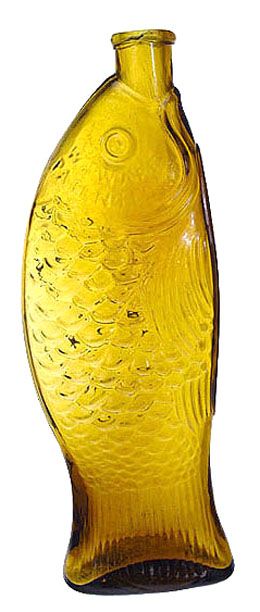  -A
recently created website on the bottles of the Michigan's Upper Peninsula
entitled "Copper Country Bottles" is
available at the following link:
https://coppercountrybottles.com/ To quote
from the website homepage - "This site catalogs old bottles of the
Copper Country, a historic copper mining region, settled in the 1840s and
encompassed by Keweenaw, Houghton, Ontonagon, and Baraga counties in
Michigan's Upper Peninsula. Our focus is on the local bottles made by
the traditional method of mouth-blowing glass into a mold and hand finishing
the top. Such Copper Country bottles date from the 1860s to 1910s.
We hope this site can facilitate the collecting and studying of old bottles
as artifacts of local history." This website was created by Jason
Oyadomari and Richard Dana and is very well done. It is full of well
researched information relative to the dating of bottles which may have
broader application outside the noted area of coverage. -A
recently created website on the bottles of the Michigan's Upper Peninsula
entitled "Copper Country Bottles" is
available at the following link:
https://coppercountrybottles.com/ To quote
from the website homepage - "This site catalogs old bottles of the
Copper Country, a historic copper mining region, settled in the 1840s and
encompassed by Keweenaw, Houghton, Ontonagon, and Baraga counties in
Michigan's Upper Peninsula. Our focus is on the local bottles made by
the traditional method of mouth-blowing glass into a mold and hand finishing
the top. Such Copper Country bottles date from the 1860s to 1910s.
We hope this site can facilitate the collecting and studying of old bottles
as artifacts of local history." This website was created by Jason
Oyadomari and Richard Dana and is very well done. It is full of well
researched information relative to the dating of bottles which may have
broader application outside the noted area of coverage.
-Noted soda
bottle researcher Ron Fowler recently completed a website that
includes a searchable database of over 21,000
(!)
different embossed Hutchinson soda bottles that he has cataloged,
including images of thousands of them. It is available a this link:
http://www.hutchbook.com/default.html This website
is a marvelous
resource for those trying to identify soda bottles and fragments as well as so much
more.
The following recently published books are useful references on some
interesting historic bottle "niches" that include American, English and/or
Continental European bottles made from the 17th century into the 20th.
All are exceptional books on their field of study and worthy of addition to
ones historic bottle library:
Farnsworth, Kenneth B. and John A. Walthall. 2011. Bottled in Illinois
- Embossed Bottles and Bottled Products of Early Illinois Merchants from Chicago
to Cairo 1840-1880. Illinois State Archaeological Survey, Prairie
Research Institute, Studies in Archaeology No. 6, University of Illinois,
Urbana, Illinois.
This is a
truly monumental work on historic bottles dealing with 19th century Illinois
bottles made during the period noted by the title.
It certainly ranks as one of a handful of the most well done books on bottles
and their history ever published in the U.S. Click
Bottled in Illinois to read more about the book and where to
acquire it.
Burton, David with research by Christopher Mortimer.
2015. Antique Sealed Bottles - 1640-1900 - and the families who
owned them. Antique Collectors Club Ltd., Woodbridge, Suffolk,
England.
This is a recent, incredibly comprehensive and massive (3
volumes, 1711 pages, and about 20 pounds!) work on the sealed bottles of the
world, which were primarily the products of English, Continental and
some American glass makers. Thousands of high quality color images and a
wealth of historical information that is almost unbelievable in scope.
Highly recommended for anyone interested in the legend, lore and history of
sealed bottles...and anyone interested in a work on historic bottles that
stands head and shoulders above the rest. It is also a very useful
work on the evolution of bottle shapes and styles as it covers many hundreds
of sealed bottles with dates from the mid-17th century through the 19th
century. This work is obviously the
authors life work (Mortimer died in 2008).
Jones, David. 2017.
Saving the Fizz - The Evolution of Patented Bottle Closures Since the
Humble Cork. Ligare Pty. Ltd., Riverwood, NSW, Australia.
This is a truly monumental work (616 pages) by the late Mr. Jones which is
highly recommended for those interested in the closures bottles used;
closures (and related finishes) which can be quite useful in dating historic
bottles in the US, Australia as well as much of the world. Profusely
illustrated (thousands of images and illustrations) covering patented
closures - and the finishes that accepted them - from the early 19th century
through much of the 20th. As the name implies, it concentrates
somewhat on closures for soda/mineral water bottles, but covers all types.
This book is still available (for about $200 US shipped) from Wayne Harris
in Traralgon, Victoria, Australia. His email is
waynhbotl@yahoo.com or by visiting the following website -
www.savingthefizz.com
One more recently published book of some interest is the following on the
products of the J. C. Ayer & Co.:
Hoyt, Cliff & Linda.
2018. A Century of Cures - Dr. J. C. Ayer & Co. Lowell, Mass.
U.S.A. Lowell Historical Society, P.O. Box 1826, Lowell, MA. 01853.
A monumental, almost 500 page work on everything about this dominant patent
medicine producer which spanned a century from the 1840s to 1940s.
History, full color illustrations of bottles, advertising, and in particular
dates on the plethora of different bottles used by Ayers during its long
history. This is a very worthwhile book to have in my opinion.
This book is available from the authors for $50 plus postage via their
website: www.cliffhoyt.com
|
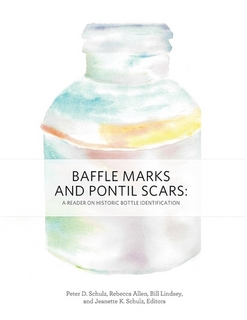 This huge (555 pages),
recently released work is one of the best "bottle books" there is for
helping with the complicated subject of bottle dating & identification. This
book includes - for the first time in print - a summary of this websites (Historic
Glass Bottle Identification & Information Website) bottle dating
key as a chapter entitled "Summary Guide to Dating Bottles" by this author
(p. 33 to 49). It also includes "Bottle Dating Worksheets" (p. 51 to
55) by Dr. Rebecca Allen and this author to assist in the systematic dating of
an historic bottle based on the information in that dating key as well as
other information on the website.
This huge (555 pages),
recently released work is one of the best "bottle books" there is for
helping with the complicated subject of bottle dating & identification. This
book includes - for the first time in print - a summary of this websites (Historic
Glass Bottle Identification & Information Website) bottle dating
key as a chapter entitled "Summary Guide to Dating Bottles" by this author
(p. 33 to 49). It also includes "Bottle Dating Worksheets" (p. 51 to
55) by Dr. Rebecca Allen and this author to assist in the systematic dating of
an historic bottle based on the information in that dating key as well as
other information on the website. 






